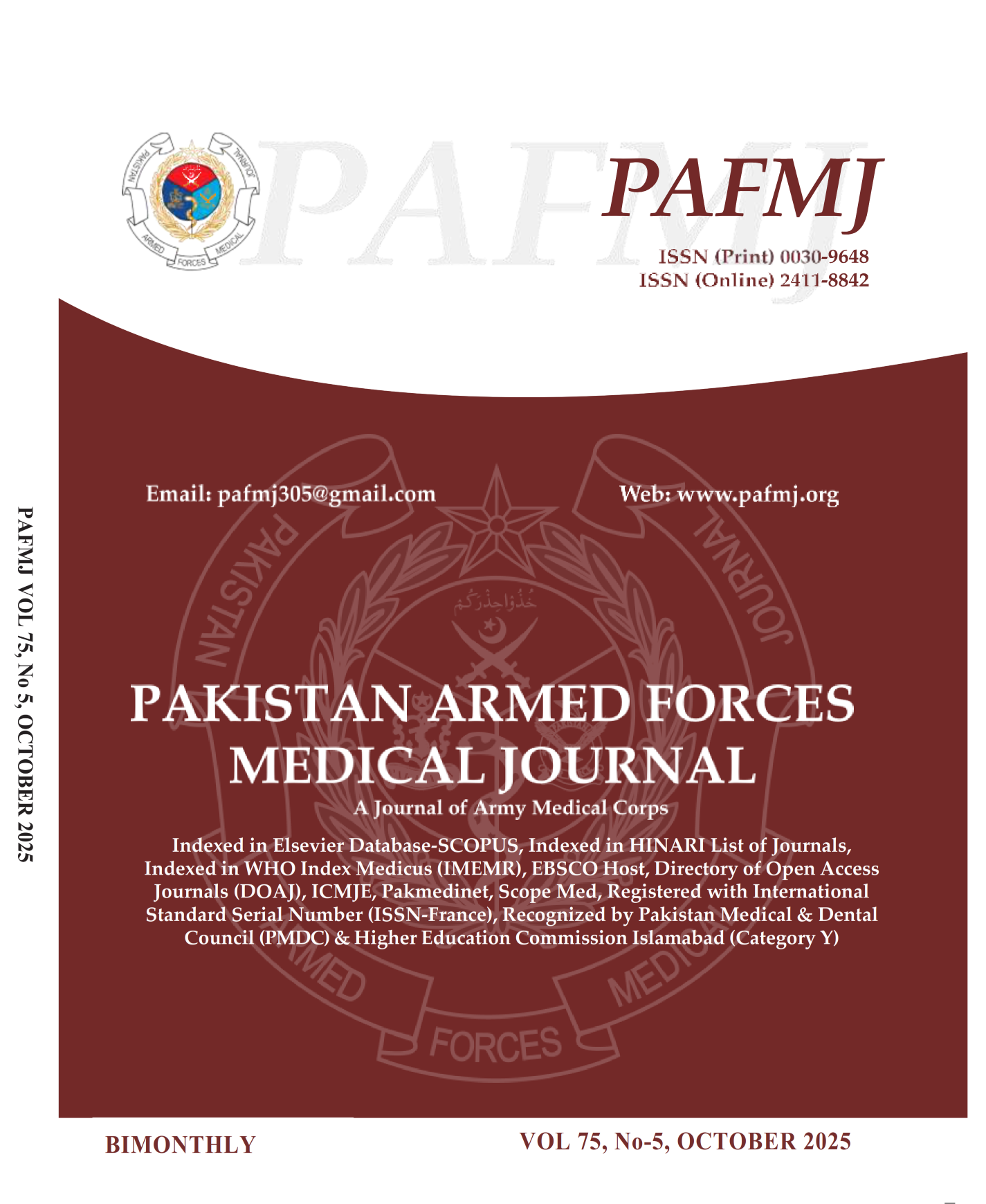Clinical Profile and Outcome of Mechanically Ventilated Neonates In A Resource-Limited Neonatal Intensive Care Unit
DOI:
https://doi.org/10.51253/pafmj.v75i5.11566Keywords:
Mechanical Ventilation, Neonates, Perinatal Asphyxia, Respiratory Distress, SepsisAbstract
Objective: To determine the clinical profile and outcome of mechanically ventilated neonates in a resource-limited neonatal intensive care unit.
Study Design: Prospective longitudinal study.
Place and Duration of Study: Department of Pediatrics Combined Military Hospital Sialkot Pakistan, from Apr to Sep 2022.
Methodology: Records of 150 neonates admitted to our neonatal intensive care unit (NICU) who underwent mechanical ventilation within the specified period were reviewed. We recorded their gestational age, birth weight, mode of delivery, APGAR scores, maternal medical history, admitting diagnosis and the indication for mechanical ventilation. They were followed for duration of ventilation, complications and outcomes. Chi square test was used to check for association between the variables.
Results: The most common indication for ventilation was severe respiratory distress with inability to maintain oxygenation in 104(69.33%) cases, followed by perinatal asphyxia with ineffective ventilation in 19(12.66%) cases. Notable associated conditions among ventilated neonates included sepsis in 57(38.00%) respiratory distress syndrome in 27(18.00%) and meconium aspiration syndrome in 18(12.00%) neonates. The frequency of survival for ventilated neonates was 52(34.66%).
Conclusion: The predominant reason for initiating mechanical ventilation was severe respiratory distress with inability to maintain oxygenation. Sepsis was the most frequent condition associated with mechanical ventilation.
Downloads
References
1. Haidry, B. Bacteria causing early onset sepsis in neonates admitted in neonatal intensive care unit of a military hospital in Muzaffarabad, Azad Kashmir Pakistan. J Dow Univ Heal Sci 2023; 17(2): 567-571.
https://doi.org/10.36570/jduhs.2023.2.1843
2. Ali R, Mahmud S. Nasal high-frequency oscillatory ventilation versus nasal intermittent positive pressure ventilation in pre-terms with respiratory distress syndrome during early neonatal period: a randomized controlled trial. Paki Armed Forces Med J 2023; 73(1): 151-154. https://doi.org/10.51253/pafmj.v73i1.8186
3. Blackwood B, Tume LN, Morris KP, Clarke M, McDowell C, Hemming K. Effect of a sedation and ventilator liberation protocol vs usual care on duration of invasive mechanical ventilation in pediatric intensive care units: a randomized clinical trial. J Am Med Assoc 2021; 326(5): 401-410. https://doi.org/10.1001/jama.2021.10296
4. Popowicz H, Kwiecień-Jaguś K, Olszewska J, Mędrzycka-Dąbrowska WA. Pain Scales in Neonates Receiving Mechanical Ventilation in Neonatal Intensive Care Units–Systematic Review. J Pain Res 2020: 1883-1897.
https://doi.org/10.2147/JPR.S248042
5. Van Kaam AH, De Luca D, Hentschel R, Hutten J, Sindelar R, Thome U. Modes and strategies for providing conventional mechanical ventilation in neonates. Pediatr Res 2021; 90(5): 957-962.
https://doi.org/10.1038/s41390-019-0704-1
6. Naylor L, Clarke-Sather A, Weber M. Troubling care in the neonatal intensive care unit. Geo Forum 2020; 114: 107-116.
https://doi.org/10.1016/j.geoforum.2020.05.015
7. Regan W, Benbrik N, Sharma SR, Auriau J, Bouvaist H, Bautista- Rodriguez C. Improved ventilation in premature babies after transcatheter versus surgical closure of patent ductus arteriosus. Int J Cardiol 2020; 311: 22- 27.
https://doi.org/10.1016/j.ijcard.2020.03.040
8. El-Masry H, Aladawy MA, Sayed MM, Mahmoud DH. Risk factors for pneumothorax in ventilated neonates admitted to neonatal intensive care unit (NICU). Ann Neonatol J 2021; 3(2): 70-87.
https://doi.org/10.21608/ANJ.2021.68034.1023
9. Hussain S, Hussain M, Ullah I, Shah SA. Barriers to the implementation of continuous positive airway pressure (cpap) ventilation in neonates at birthplace in tertiary care teaching hospitals.
Pak Armed Forces Med J.2022; 72(3): 1114-1119.
https://doi.org/10.51253/pafmj.v72i3.7328
10. Kim KT, Knopp J, Dixon B, Chase G. Quantifying neonatal pulmonary mechanics in mechanical ventilation. Biomed Signal Process Control 2019; 52: 206-217. https://doi.org/10.1016/j.bspc.2019.04.015
11. Sultana SN, Khan MM, Islam MT, Afroze S, Jahan I, Dey SK. Clinical profile and outcome of neonates requiring mechanical ventilation. Birth 2019; 37(11): 20-28. https://doi.org/10.21276/ijmrp.2020.6.1.025
12. Khushdil AK, Waqar T, Ahmed Z. Outcome of neonates ventilated in NICU of a tertiary care hospital and factors associated with poor outcome. Pak Armed Forces Med J 2018; 68(2): 300-304.
13. Iqbal Q, Younus MM, Ahmed A, Ahmad I, Iqbal J, Charoo BA, et al. Neonatal mechanical ventilation: Indications and outcome. Indian journal of critical care medicine: peer-reviewed, official publication of Indian Soc Crit Care Med 2015; 19(9): 523-529.
https://doi.org/10.4103/0972-5229.164800
14. Mokhtar WA, Sherief LM, Kamal NM, Kamel SE. Mortality rate in mechanically ventilated neonates: a developing country experience. Iran J Neonatol 2021; 12(2).498-502
https://doi.org/10.22038/ijn.2021.33734.1488
15. Shrestha S, Sindan N, Kayastha N, Karki DB, Jha K, Thapa SD. Clinical profile and outcome of neonates admitted to the Neonatal Care Unit in a rural teaching Hospital. J Karnali Acad Health Sci 2018; 1(02): 23 https://doi.org/10.3126/jkahs.v1i2.24130
16. Prabha PCN, Georg RT, Francis F. Profi le and outcomes of neonates requiring ventilation: The Kerala Experience. Curr Pediatr Res 2014; 18(2): 57-62. ISSN 0971-9032
17. Alharbi MF, Marzouk SA, Alrashidi N, Abu-Alghayth MH, Mater EA, Ibrahim MA, et al. Effectiveness of nurses’ training about mechanical ventilation weaning on neonatal outcomes. BMC Nurs 2025; 24(1): 654. https://doi.org/10.1186/s12912-025-03257-9
18. van Kaam AH. Optimal strategies of mechanical ventilation: can we avoid or reduce lung injury? Neonatology 2024; 121(5): 570-575.
Downloads
Published
Issue
Section
License
Copyright (c) 2025 Raiha Ashfaq, Muhammad Aatif, Faisal Basheer, Amjad Iqbal, Wajahat Maqbool, Ameer Hamza

This work is licensed under a Creative Commons Attribution-NonCommercial 4.0 International License.















